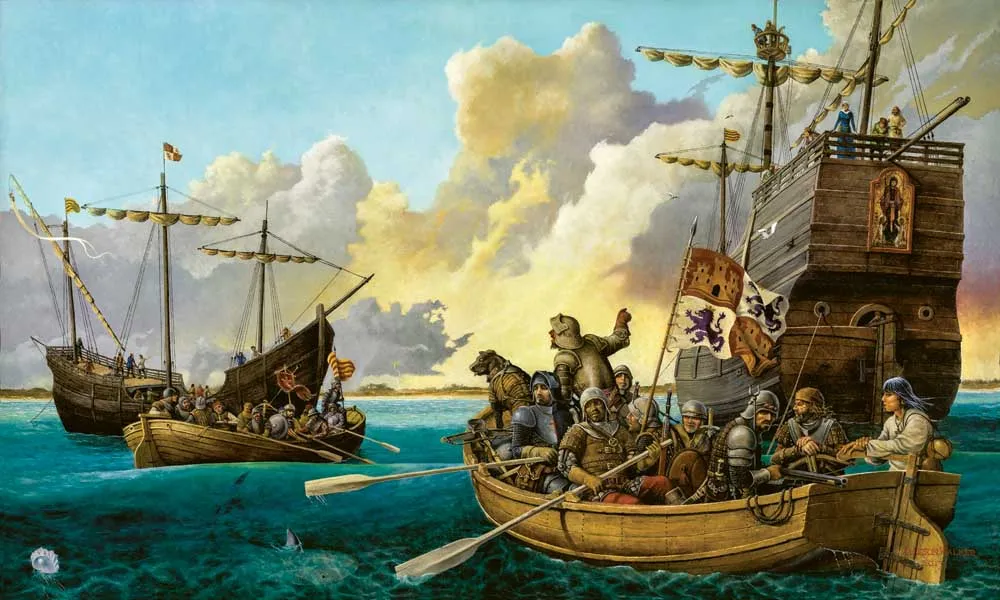Artist Jackson Walker has dedicated his life to preserving Florida history through large oil paintings.
“I got to thinking about Florida, and my own family’s history, and it just kind of dawned on me, well that’s what you know, that’s where you live, that’s who you are,” says Walker.
His 48 x 72 inch painting “They called it La Florida: The First Landing of Ponce de León in Florida, April 2, 1513” will be on display July 17 through December 11 at the Brevard Museum of History and Natural Science in Cocoa as part of the “ArtCalusa: Reflections on Representation” exhibition.
The opening reception is this Friday evening from 6pm to 8pm. Tickets are available at www.myfloridahistory.org. Walker will be on hand to sign prints of the painting, and his book of Florida art.
The cover of the book “Recovering Moments in Time: The Florida History Paintings of Jackson Walker” features a realistic image of Teddy Roosevelt and the Rough Riders on horseback in Tampa in 1898. The fanciful towers of the Tampa Bay hotel can be seen in the background.
Theodore Roosevelt was the 26th president of the United States, from 1901 to 1909. Several years before that, as a member of the First United States Cavalry, also known as the Rough Riders, Roosevelt and his regiment camped in Tampa while awaiting transport to Cuba during the Spanish American War.
Other notable people depicted in Walker’s paintings include naturalist William Bartram, Seminole Chief Osceola, writer Marjorie Kinnan Rawlings, and anthropologist Zora Neale Hurston.
Walker is a native Floridian, born in Panama City and raised in Stuart. His varied career includes two combat tours in Viet Nam with the U.S. Army, work in graphic design and advertising, and time as a singer songwriter.
“I wanted to try oil painting as a very young guy, and struggled with it all of my life,” says Walker. “In fits and finishes my career would steadily go forth, but I had to depend on other means until I came to Orlando.”
When Walker and his wife Nancy moved to Orlando in 1990, he decided to try painting full time.
“About that same time I’d reached the level that I thought I would attempt something really grand,” says Walker. “That was the beginning of the Legendary Florida series.”
Most of Walker’s Legendary Florida series is on display at the Historic Volusia County Courthouse in DeLand. In 2004, the Museum of Florida Art purchased what was then the entire series of Jackson Walker’s Florida history paintings to display in the historic venue.
His paintings are also on permanent display in Washington, D.C., Tallahassee, and Orlando.
“Nobody had really approached the idea of actually producing a collection of Florida history,” Walker says. “A lot of people have done Florida history paintings in the past, but I wanted to do an entire project of nothing but recovering and portraying, in nice big works, the history of Florida, the incidents and personalities that have made the state what it is, and how it got to be what it is.”
Some of Walker’s paintings depict well known topics from Florida history such as the capture of Chief Osceola during the Second Seminole War and the Battle of Olustee in the Civil War.
Other works focus on lesser known stories from Florida’s past such as the activity of German submarines off the coast of Florida during World War II and the shootout between Ma Barker’s family of gangsters and federal agents.
“The concept was to do Florida history, but I didn’t want to do the most obvious,” says Walker. “There are thousands of stories that are just slipping away, so I try to seek out some of the more interesting stories.”
Walker conducts extensive research to make each detail of his paintings as accurate as possible. He studies descriptions in historical documents, historic images, and objects in museums.
“I’ve tried as much as humanly possible to recover these instances and these places and times accurately and honestly,” says Walker. “I got everything I wanted out of being an artist by just turning to my Florida roots and discovering the history, and hopefully retaining some of the history that may get lost.”
